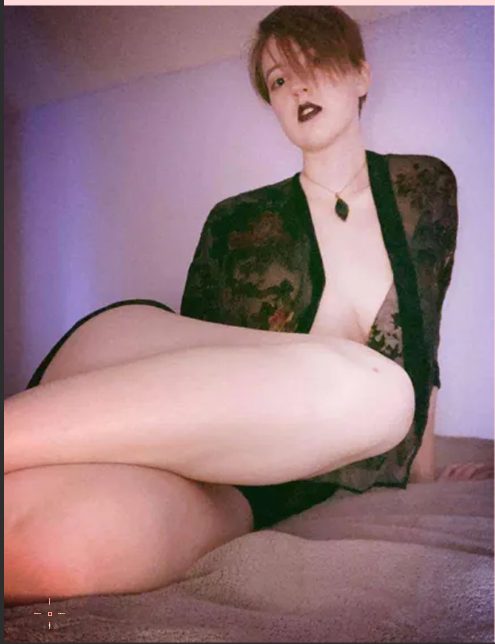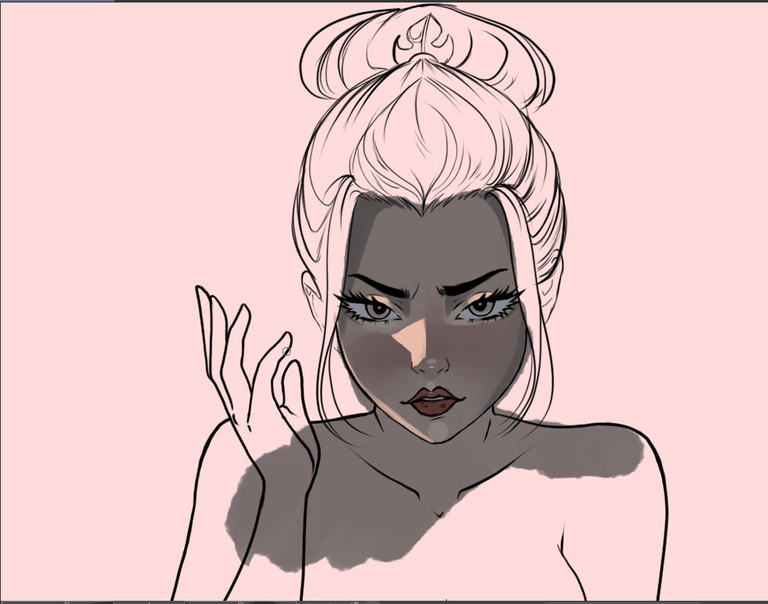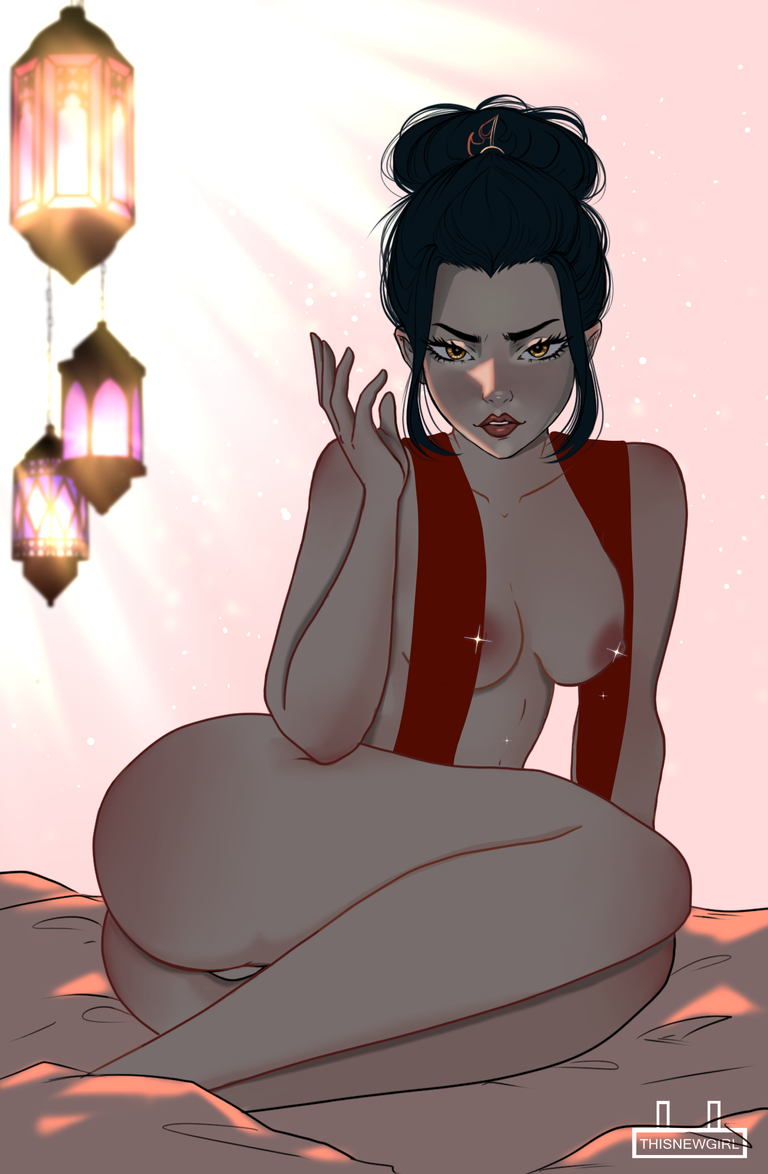
Hello ! thanks for visiting my blog, this is a compilation of the whole process of this commission for a special client, in which I was working about 4 days.
since I have other responsibilities I dedicate 3 or 4 hours a day to illustration. if you like art processes I invite you to read my article, with the step by step and to leave your like if at the end of the reading you like what I do, you help me a lot and it doesn't cost you anything C:
Hola ! gracias por visitar mi blog, esta es una recopilación de todo el proceso de este encargo para un cliente especial, en el cual estuve trabajando unos 4 días.
como tengo otras responsabilidades dedico 3 o 4 horas diarias a la ilustración. si te gustan los procesos artísticos te invito a leer mi artículo, con el paso a paso y a dejar tu like si al final de la lectura te gusta lo que hago, me ayudas mucho y no te cuesta nada C:
The Importance of References in Art

( this image is the reference of the pose that the client wanted, not all the images that the client shares are going to be perfect but I as an artist I take care of giving it dynamism, in the shadows the lights and adding more silhouettes in the poses.)
( esta imagen es la referencia de la pose que el cliente quería, no todas las imágenes que el cliente comparte van a ser perfectas pero yo como artista me encargo de darle dinamismo, en las sombras las luces y añadir más siluetas en las poses).
Whenever I am going to make a commission on something my client wants, I always ask for a reference of what he wants.
because I understand images better than a vague explanation or definition of what they want in the artwork, and let's face it... not many are good at explaining and being specific in what they want.
this goes hand in hand with the first one, we save time of corrections for misunderstandings, since a visual composition is (for me) much clearer and I end up delivering what he wants because I understood the message.
As artists, we all have a unique style that sets us apart from others, but we have to admit that references play a critical role in our creative process. Whether it's a still life or a landscape, having references helps elevate the quality of our work and enables us to explore new techniques and styles.
ESP
Siempre que voy a hacer un encargo de algo que mi cliente quiere, le pido una referencia de lo que quiere.
porque entiendo mejor las imágenes que una vaga explicación o definición de lo que quieren en la obra, y seamos sinceros... no muchos son buenos explicando y siendo específicos en lo que quieren.
esto va de la mano con lo primero, ahorramos tiempo de correcciones por malos entendidos, ya que una composición visual es (para mi) mucho más clara y termino entregando lo que él quiere porque entendí el mensaje.
Como artistas, todos tenemos un estilo único que nos diferencia de los demás, pero tenemos que admitir que las referencias desempeñan un papel fundamental en nuestro proceso creativo. Tanto si se trata de un bodegón como de un paisaje, tener referencias ayuda a elevar la calidad de nuestro trabajo y nos permite explorar nuevas técnicas y estilos.
Why Are References Important?
Using references allows us artists to add depth and realism to our work. Different references can provide different moods, lighting, and composition that we may not be able to conceive in our minds. Natural lighting in nature can inform how to render textures in a drawing, while the angles of shadows in photographs can help us understand how to create depth and dimension for a painting.
The more references we use and experiment with, the more diverse our work can become. By becoming comfortable with references, artists can explore other techniques and mediums and adapt them to their own style.
Types of References
There are different types of references that artists can use to develop their work. Some common types are:
Nature: Many artists take inspiration from the environment around them. Nature provides an array of subjects just begging to be captured. From something as small as a leaf or a rock to something as grandiose as a mountain range, nature offers a lot of variety that artists can use as references.
Photographs: Photography is an art form that can be used as a reference. Photographs offer an excellent representation of the real world that artists can use in their work. Plus, images are easy to find and affordable, making it an accessible reference for artists looking to experiment.
Live Models: Using live models or sitting outdoors for plein air painting enables artists to capture realistic glimpses of the world around them. From capturing subtle changes in light or the movements of a person, working with live models can help an artist hone their skills and create genuinely breathtaking art.
ESP
¿Por qué son importantes las referencias?
El uso de referencias nos permite a los artistas añadir profundidad y realismo a nuestro trabajo. Diferentes referencias pueden proporcionar diferentes estados de ánimo, iluminación y composición que quizá no seamos capaces de concebir mentalmente. La iluminación natural puede ayudarnos a representar las texturas en un dibujo, mientras que los ángulos de las sombras en las fotografías pueden ayudarnos a entender cómo crear profundidad y dimensión en un cuadro.
Cuantas más referencias utilicemos y experimentemos, más diverso será nuestro trabajo. Al sentirse cómodo con las referencias, el artista puede explorar otras técnicas y medios y adaptarlos a su propio estilo.
Tipos de referencias
Hay distintos tipos de referencias que los artistas pueden utilizar para desarrollar su obra. Algunos tipos comunes son:
La naturaleza: Muchos artistas se inspiran en el entorno que les rodea. La naturaleza ofrece una gran variedad de temas que piden a gritos ser captados. Desde algo tan pequeño como una hoja o una roca hasta algo tan grandioso como una cadena montañosa, la naturaleza ofrece una gran variedad que los artistas pueden utilizar como referencia.
Fotografías: La fotografía es una forma de arte que puede utilizarse como referencia. Las fotografías ofrecen una excelente representación del mundo real que los artistas pueden utilizar en sus obras. Además, las imágenes son fáciles de encontrar y asequibles, lo que las convierte en una referencia accesible para los artistas que buscan experimentar.
Modelos vivos: Utilizar modelos vivos o sentarse al aire libre para pintar en plein air permite a los artistas captar destellos realistas del mundo que les rodea. Desde captar sutiles cambios de luz hasta los movimientos de una persona, trabajar con modelos vivos puede ayudar a un artista a perfeccionar sus habilidades y crear obras de arte realmente impresionantes.
sketch

I always start with a sketch, wich is a quick drawing, made with simple strokes and without focusing on detail or precision. nothing perfect, sketches are used as part of the creative process, as a way to make preliminary sketches of an artwork or design before creating the final version. In any case, sketches are a valuable tool to help writers and artists explore concepts and effectively communicate ideas to the audience.
We just wanna kinda see what we want, explore, as you see here, the shoulders are suuuuuper different from the final result.
ESP
Siempre empiezo con un boceto, que es un dibujo rápido, hecho con trazos sencillos y sin centrarse en el detalle o la precisión. Nada perfectos, los bocetos se utilizan como parte del proceso creativo, como una forma de hacer esbozos preliminares de una obra de arte o diseño antes de crear la versión final. En cualquier caso, los bocetos son una herramienta valiosa para ayudar a escritores y artistas a explorar conceptos y comunicar ideas de forma eficaz al público.
Sólo queremos ver más o menos lo que queremos, explorar, como ves aquí, los hombros son suuuuuper diferentes del resultado final.
clean lineart

Clean lineart refers to the precise and well-defined lines in an artwork or illustration (: and what i mean is it typically involves using clean, smooth, and consistent lines to define the shapes, contours, and details of the subject.
So guys the purpose of clean lineart is to create a clear and visually appealing outline of the subject. It helps to establish the structure and form of the artwork, making it easier to understand and appreciate. Clean lineart is especially important in certain art styles.
Overall, a clean lineart plays a crucial role in creating visually appealing and professional-looking artworks, providing a solid foundation for coloring, shading, and further detailing.
ESP
El trazo limpio se refiere a las líneas precisas y bien definidas en una obra de arte o ilustración (: y lo que quiero decir es que normalmente implica el uso de líneas limpias, suaves y consistentes para definir las formas, contornos y detalles del sujeto.
El objetivo de un trazo limpio es crear un contorno claro y visualmente atractivo del tema. Ayuda a establecer la estructura y la forma de la obra de arte, facilitando su comprensión y apreciación. El trazo limpio es especialmente importante en determinados estilos artísticos.
En general, un trazo limpio desempeña un papel crucial en la creación de obras de arte visualmente atractivas y de aspecto profesional, proporcionando una base sólida para el coloreado, el sombreado y otros detalles.
Lets start playing around with colors

I will always, ALWAYS start applying color on the face and define where my highlights are going to come from.
This is the way I work, other artists apply the highlights after, ALL of them, I apply where I feel comfortable even if I'm not on point or on the highlight layer.
this time I decided to take reference from other colors in other compositions, and surprise, the color of the skin I started with a gray and depending on what background colors you have, the color theory will work its magic.
ESP
Yo siempre, SIEMPRE empiezo aplicando color en la cara y defino de donde van a venir mis luces.
Esta es mi forma de trabajar, otros artistas aplican las luces después, TODOS, yo aplico donde me siento cómodo aunque no esté en el punto o en la capa de luces.
esta vez decidí tomar referencia de otros colores en otras composiciones, y sorpresa, el color de la piel lo empecé con un gris y dependiendo de que colores de fondo tengas, la teoría del color hará su magia.
Base flat colors

the usual, once you have your colors defined can of paint and begin to fill in the spaces.
ESP
lo de siempre, una vez tengas tus colores definidos lata de pintura y empieza a rellenar los espacios.
Base colors with shadows

Lights and hair lines

doing the hair and highlights is my favorite part... because it involves so many things, making it look pretty, pencils, sprays, blending and not to mention how relaxing I find drawing hair.
we can also see how little by little it begins to take life, and here I have placed the lights on the skin.
ESP
hacer el pelo y las luces es mi parte favorita... porque implica tantas cosas, hacer que quede bonito, lápices, sprays, difuminar y no digamos lo relajante que me resulta dibujar el pelo.
también podemos ver como poco a poco empieza a tomar vida, y aquí he colocado las luces sobre la piel.
No faded lights

this is what it looked like before blurring the bust lines
ESP
este es el aspecto que tenía antes de difuminar las líneas del busto
All lights and color corrections


Close up!
Background


The program I use : :
- Clip studio
tool to illustrate:
- Huion canva
If you like what I do, leave a like ! it doesn't cost you anything and you help me a lot to keep doing what I like.
You can find me on:
instagram as:
https://instagram.com/this.newgirl?utm_source=qr&igshid=ZDExYjZkNGI0OA==

and in Showroom as :
https://nftshowroom.com/thisnewgirl/gallery

Your style never ceases to amaze me. No matter what you draw someone can almost instantly recognize it as one of your creations!
Do you really think so?
sometimes I think that my style is not recognizable XD but, the best thing is that, every time I do something, I feel that it is better than the last one and that makes me happy.
Yes maam. I can definitly see your style. ie look at the Loud & Proud art you did a few years ago and then look at the one from your post. Put them side by side and you can see the similarites. They look different but I can see your personality in them.
It's similar to musicians. You can listen to the same song played by different artists and the people who are familiar with the musician can tell them apart.
It's really obvious with guitarists. You can hear some of them and know immeadiately who they are without seeing them. Even on songs that are not thiers.
When you personality shows through continued improvements and techniqe.
Thats what makes a great artist.
Es un trabajo hermoso, me encanto la composición y la expresión del personaje. 😍
I love your style, the work is so clean and she looks adorable
thank you C: im always trying my best, and bring joy to clients C: